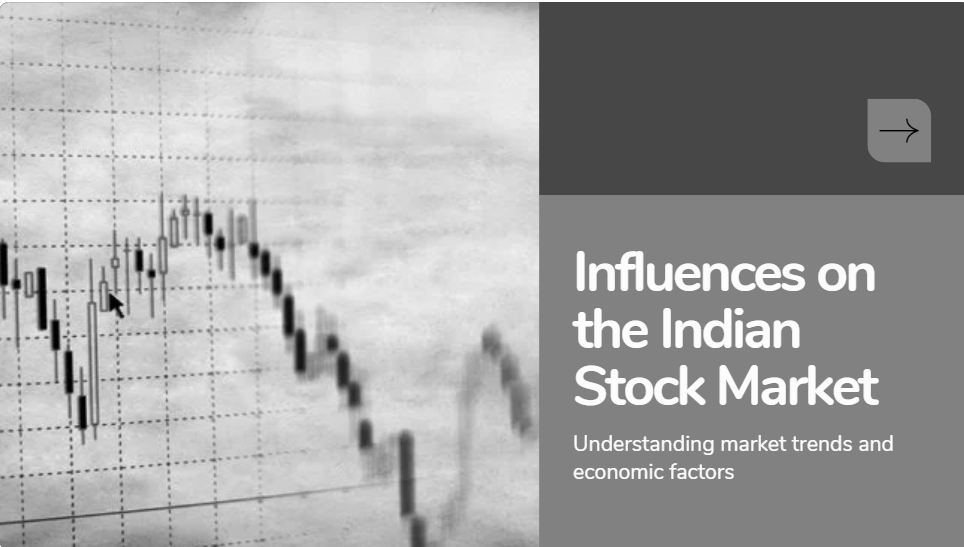
Table of Contents
Overview
Numerous factors interact to shape market trends in the dynamic ecosystem that is the Indian stock market. This article examines the top 7 influences on the Indian stock market and how they affect market movements. Knowing these factors can help you make better financial decisions, regardless of your level of experience. In order to keep you ahead of the curve, I provide case studies, expert strategies, and practical insights in this guide that center on the factors influencing the Indian stock market.
1. GDP Growth Rate and Macroeconomic Data
One of the biggest factors affecting the Indian stock market is macroeconomic data. The general mood of the economy is determined by important indicators like GDP growth, inflation rates, and industrial production:
- GDP Growth: Investor sentiment is raised by a strong GDP growth rate, which signifies a sound economy.
- Trends in Inflation: Market confidence is generally increased by stable inflation below 6%.
- PMI and Industrial Output: These indicators aid in determining the pace of the economy.
Take Amit, a Mumbai-based portfolio manager, as an example. When India's Q3 GDP growth was revised up to 6.5% in early 2025, Amit rebalanced his portfolio to include industries that were anticipated to gain from robust economic activity.
Amit was able to reduce risk and take advantage of rising stocks in the infrastructure and manufacturing industries by closely monitoring these macroeconomic indicators.
His success story demonstrates how keeping an eye on the factors influencing the Indian stock market, especially macroeconomic trends, can give one a competitive advantage.
2. Data on Auto Sales and Customer Demand
Sales of cars are an important indicator of both economic activity and consumer confidence. Auto sales numbers have a big influence on the stock market because they are a significant part of domestic consumption:
- Growing Sales: A sign of strong consumer spending and a thriving economy.
- Falling Figures: Indicate prudence and cause investors to reevaluate market risks.
- Sector Impact: These trends have a direct impact on businesses like Tata Motors and Maruti Suzuki.
Real-World Example: Investors immediately observed an improvement in the performance of auto stocks when monthly auto sales data revealed a significant spike in demand. By directing investment toward the automotive industry, this real-time data became one of the main factors influence on the Indian stock market.
3. Trade Tariffs & Global Market Dynamics
Indian stock market is influenced a lot by the trade policies, especially by the global powers like the USA. Recent trade tariffs by Donald Trump have caused a bout of volatility:
- Tariff Impacts: Rise in cost on Indian exports may impact earnings in sectors like IT, pharmaceuticals, manufacturing.
- Investor Sentiment: Trade uncertainties retreating by foreign institutional investors (FII), the stock indices had the pressure downwards.
- Sectorial Effects: Tariffs may impel companies to seek cost reducing strategies or move its market.
Key Takeaway:
Remaining up-to-date on global trade policy is crucial to insulating against attach associated with tariffs-induced alterity in the market.
one-year winter session Neha, equity analyst in Delhi kept a close watch on tariff updates & updates on Donald Trump announcements in recent days, Realizing the tariffs were set to go up, she told her clients, the thing to do was to cut exposure to export-heavy firms and switch into domestic-sectors.
This adaptation enabled her clients to minimize the potential for significant losses when the market fell due to the tariffs.
Neha's strategy makes it evident that one among the leading factors affecting the Indian stock market are Trade policies and it is also depicting that you should be very sharp in Investment and your investment strategies.
Foreign Institutional investors (FIIs) is among the most major factor in Indian Stock market. Investments in a specific way usually reflect whole market trends:
- Fund Inflows/Outflows: FIIs can become a market mover. Like for instance, a net fund outflow of ₹22,011 Cr in Feb 2025 had weighed the stock prices negatively.
- Sectoral Influence: FII movement mainly in the financial and IT sector generally shows correlation with the stock’s performance.
- Market Confidence: Continuous FII investment signify faith in long-term growth story of the market.
Key Takeaway:
- Vigilance on FII activity gives you a vital clue on the market for the traders for pre- act their portfolio.
Rahul, a financial planner in Bangalore keeps an eye on India Infoline (FII) movement. In February 2025, as FIIs started pulling out funds, Rahul suggested to his clients to move to stability sectors like consumer staples and utilities. This shift of manage strategy saved his clients from significant drop in value within a bearish market condition.
Rahul’s example highlights the importance of knowing the effect of Indian stock market that is especially FII fund inflows, for making prudent investment decisions.
5. INR-USD Exchange Rate & Currency Market Trends
The rate of exchange between the Indian Rupees (INR) and the United States Dollar (USD) is another of major influence on the Indian stock market:
- Export vs. Import Dynamics: A falling rupee is beneficial for exporters but is unfavorable to importers and could add to inflation.
- Impact on Investor: Change in value for currency can stand in the way of foreign investment.
- Sectoral Exposure – Sectors like IT and Pharmaceuticals, who has a high export intensity, very sensitive to currency.
Practical Example:
With the decline in the INR against the USD, the earnings of many export-based companies were soared up, which has led to positive price gain in their stock performance.
This currency movement, among the top factors that impact the Indian stock market, gave the investors the exact signal to have a stake in export driven sectors.
Key Takeaway:
Knowing currency patterns are important because they affect, first and foremost, sector performance and consequently, the general market sentiment.
6. Global Cues & Market Sentiments
The global market conditions including the decisions of the US Federal Reserve, political events around the world, international economic data impact the Indian stock market:
- US Monetary Policy: Interest rate decisions by the US Fed influence the capital inflows into India.
- Geopolitical Events: Events that trigger trade conflicts or statements about political instability lead to the global uncertainty in the markets.
- Commodity Prices: Oil price shifts and other commodity prices also impact market realities.
Case Study: Global Economic Shifts
Investment strategist Anjali further pointed out that the global cues including US Composite PMI and international tensions had instant effect on Indian markets for the most part 2025 When US PMI number came in weak, and international tensions rose, Indian market received a spate of volatility.
Anjali’s research resulted in her clients to be more defensively positioned within the investments under her care, concentrating on industry clusters that have steady profits.
Her strategy reflects that global factors are topmost in line of affecting Indian stock markets and that is the reason to have a mixed investment strategy.
Key Takeaway:
The consequences of worldwide economic activities are substantial for domestic markets; therefore, subscribers have to beware of such worldwide stances and ultimate make choice of investments according to that.
7. Earnings Reports & Corporate Performance
Indian stock market shares the quarterly earnings reports, and the corporation achievements will represent the health of the companies and plays as one of the key factors of stock market:
- Positive Earnings: Stimulate purchase and are responsible for stock rises.
- Negative Guidance: Must cause selling, impact on market indices such as Nifty 50, Sensex.
- Sector Variance – Sectors are a very different ball game altogether in the sense that all sectors do not react in the same manner with respect to earning expectations as well their outlook.
Practical Example:
Those following the quarterly reports of the largest companies in the IT and banking sectors have seen good earnings in these sectors were contributed to the market sentiment.
These reports, major forces of the Indian stock market, nudged investors to re-jig their assets, exploit growth opportunities The or the Medium.
In conclusion
The factors influence on the Indian stock market are varied and ever-changing. Every element adds to the intricate web of market trends, from corporate earnings and global market cues to FII fund flows and macroeconomic indicators.
Investors and traders can create strong strategies to manage market volatility and take advantage of growth opportunities by comprehending these important influences.
Important Suggestions for Investing:
- Keep an eye on economic indicators: Keep abreast of PMI, GDP, and inflation data.
- Monitor FII Motions: To determine the mood of the market, monitor the flows of foreign funds.
- Examine worldwide trends: Recognize the effects of trade policies and global cues.
- Examine the earnings reports: Your investment strategy should be informed by quarterly performance data.
By using these observations and actual case studies, you can better comprehend the influences on the Indian stock market.
Frequently Asked Questions
How do macroeconomic factors influences the Indian stock market?
+Macroeconomic data, such as GDP growth and inflation, are critical influences on the Indian stock market that determine investor sentiment and overall market performance.
Why are foreign institutional investors important for market trends?
+FIIs are a major influence on the Indian stock market because their investment decisions can lead to significant market movements.
How can trade tariffs affect Indian stocks?
+Trade tariffs can increase export costs, impacting company profits and serving as a key influence on the Indian stock market.
What role does the INR-USD exchange rate play in market dynamics?
+Currency fluctuations are a vital influence on the Indian stock market, affecting sectors like IT and pharmaceuticals due to changes in export competitiveness and import costs.
How do global cues impact the Indian stock market?
+Global economic trends, geopolitical events, and commodity prices are major influences on the Indian stock market, impacting investor confidence and market stability.
How important are earnings reports for stock market analysis?
+Earnings reports provide direct insights into company performance and are crucial influences on the Indian stock market that help investors make informed decisions.







Pingback: 4 Year Presidential Cycle Stock Market Trends & Insights
Pingback: Best Penny Stocks for Long-Term Growth | Expert Picks
Pingback: Equity Market Correction: Causes & Smart Investment Tips
Pingback: How to Buy Tesla Stock in India – Step-by-Step Guide